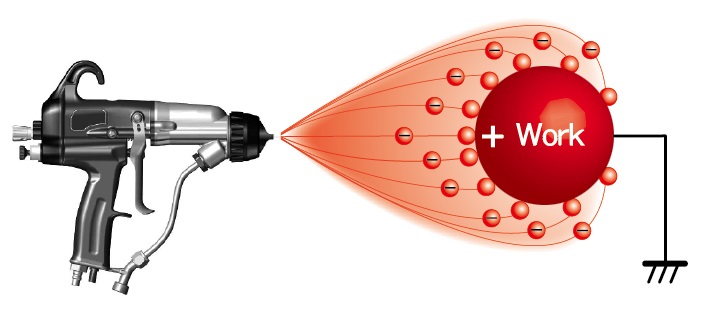
ANZAC Day Closure
AA Spray will be closed on Thursday 25th April and Friday 26th April. We will re-open on Monday 29th April at 8.00am.
Orders placed during this period will not be despatched until the 29th April 2024.

Electrostatic spray painting was first patented in the U.S.by Harold Ransburg in the late 1940s after which he formed the company "Ransburg Electrostatic Equipment".
Electrostatic spray painting guns have an electrode located after the nozzle which charges the paint particles as they atomize, the charged paint particles will naturally attract to a grounded object when sprayed.

Electrostatic spray painting increases transfer efficiency because charged paint particles will attract to the natural earth of the object being sprayed, in many cases the paint will actually wrap around the object reducing overspray, paint consumption and overspray.
Application of electrostatic painting can be divided into two categories of work -
1) On-Site Applications
On-Site electrostatic spray painting will be for applications such as spraying window and door frames, elevator doors, office filing cabinets, metal construction stair cases, hand railings and balustrades.
2) Production Applications
Production applications will be in a fixed location usually a spray booth or conveyor line. The type of work would generally be spraying metal fabricated components, structural steel, steel frames and pipes etc.
Why would you choose to use an electrostatic spray system?
Depending on your application you will be either spraying on site or in a fixed location for production applications, the main reasons for using electrostatic spray systems will be –
1) Reduced Paint Consumption
Electrostatic spray painting can reduce paint consumption up to 50%, the charged paint particle being attracted to the grounded object will reduce overspray and allow in many cases the spray pressure to be turned down reducing overall wastage.
For example, a production line spray application where the same objects are being sprayed every day may consume $100,000 worth of paint annually using a conventional spraying system. If the product line spraying was changed to an electrostatic spraying system and it reduced overspray by as little as 30% (which is will vary depending on the paints being used) that would be a saving of $30,000 every year. Savings like this would justify the initial cost of an electrostatic spraying system.
On the other end of the scale, if annual paint consumption was only $10,000 per year with the same paint savings of approximately 30%, this would only save $3000 per year. In this case it would be hard to justify the cost of changing to an electrostatic spray system as it would take almost three years to break even on the cost of the equipment v’s paint savings.
2) Application Coverage
If you were spraying irregular shaped objects such as window frames, pipes or fabricated steel brackets with holes and flanges etc, these items would be difficult to spray with conventional spray guns. You would have to spray from many different angles to achieve full paint coverage and in a situation such as aluminium window frames you may not get any paint into the channels.
Electrostatic spray guns are much more effective for applying coatings into hard to get areas, the charge in the paint will tend to wrap around objects and get into areas that conventional spraying can not. Electrostatic spraying would greatly reduce the number of passes, apply paint more evenly increase application time and reduce overspray.
3) Waste Reduction
Electrostatic spray guns will reduce overspray which can assist in keeping the spray area cleaner, less overspray and fall out in the air and less paint build up in the spray booth saving money in booth filters and clean up time.
A combination of paint saving, increased paint coverage and application speed with less mess would be the main reasons for choosing an electrostatic spray system. Not all applications can just be based on paint savings, depending on the type of work that you do and the environment where the work needs to be done should also be considered.